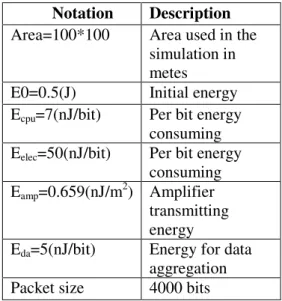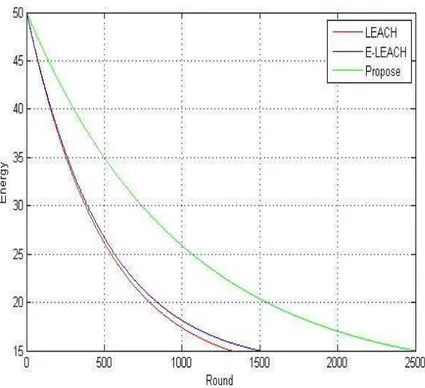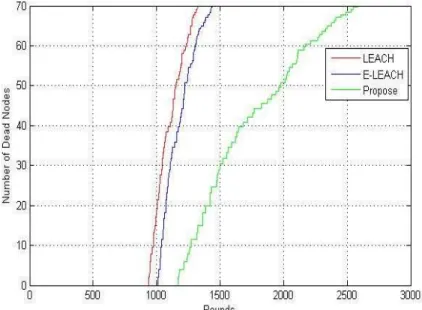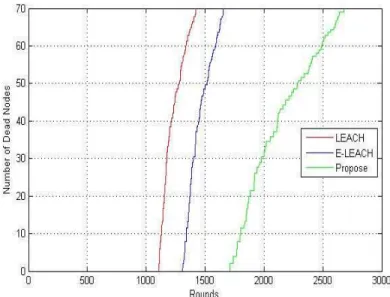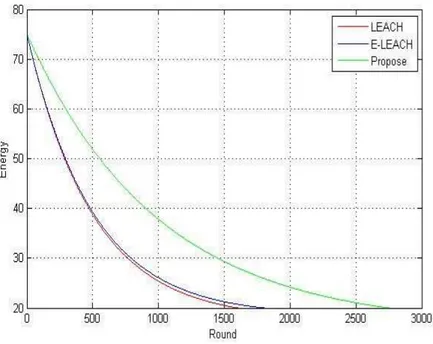DOI: 10.5121/ijwmn.2016.8404 65
Mohammad Sedighimanesh
1, Javad Baqeri
2and Ali Sedighimanesh
31,2,3
Department of Electrical, Computer and It Engineering, Islamic Azad University of
Qazvin, Qom, Iran
Abstract
One of the most important issues in Wireless Sensor Networks (WSNs) is severe energy restrictions. As the performance of Sensor Networks is strongly dependence to the network lifetime, researchers seek a way to use node energy supply effectively and increasing network lifetime. As a consequence, it is crucial to use routing algorithms result in decrease energy consumption and better bandwidth utilization. The purpose of this paper is to increase Wireless Sensor Networks lifetime using LEACH-algorithm. So before clustering Network environment, it is divided into two virtual layers (using distance between sensor nodes and base station) and then regarding to sensors position in each of two layers, residual energy of sensor and distance from base station is used in clustering. In this article, we compare proposed algorithm with well-known LEACH and ELEACH algorithms in homogenous environment (with equal energy for all sensors) and heterogeneous one (energy of half of sensors get doubled), also for static and dynamic situation of base station. Results show that our proposed algorithm delivers improved performance.
Keywords
Wireless Sensor Networks (WSNs), Routing protocols, Clustering in Wireless Sensor Networks
1.
I
NTRODUCTION66 considerable topics in these networks is energy maintenance to increase network lifetime[1, 2]. The most important issue in sensor networks is routing and the most important issue in routing is optimal energy consumption in sensors to increase network lifetime, because sensors have limited energy and are not rechargeable. These networks typically have static nodes or with limited mobility and a central node which collects sensed data from nodes directly (one-step method) or indirectly (multi-steps). In directly transmission, each sensor sends information directly to central node, because of distance between sensors and base station, a lot of energy consumed in each transmission. In contrast designs which make communication distance smaller could extend network lifetime. Clustering protocols are appropriate methods for extending WSNs lifetime. In clustering, network is divided to clusters, in each cluster a node will be selected as cluster head. Member clusters send processed data to cluster head (either directly or indirectly and by steps method). After that data are aggregated and be sent to base station using one-step or multi-steps transmission [3, 4].
In WSN, the synergy between the sensor nodes is important for two reasons [5, 6]:
- The data gathered by some sensor nodes can provide a valuable inference about the environment; that is because the data have been processed after being gathered, and by putting the data together, the good results will be obtained.
- Synergy between the sensor nodes can be considered as a kind of compromise between the cost of communications and the energy of calculations. That means that the sensors cooperate with each other and send the data to the central station step by step, instead of sending the information directly to the central station and consuming high amount of energy
The main purpose of hierarchical protocols (based on clustering) is using an appropriate method for optimal use of energy sources. This is done by multi-steps transmission in network and also combination of a cluster's information to reduce transmission data load. LEACH-protocol is one of the first hierarchical protocols introduced for WSNs and a lot of application protocols have been designed based on it.
These are reasons why LEACH-protocol is important for researchers[7, 8]:
67 -In LEACH, data transmission from nodes of a cluster to head cluster and from head cluster to base station is done using local control and doesn't need an external factor or a specific node in network to data transmission.
-MAC-protocol used in LEACH, help saving energy by relaxing sensors appropriately in time of need.
-LEACH-protocol, like other protocols based on clustering, uses combination of data in each cluster and sends compressed data to base station. So using LEACH-protocol will lead to decrease in the number of send and receive operations in network. Meanwhile, redundant data (caused by Proximity of sensors in a cluster) will be omitted before send to base station.
Hinzelmann proposed a hierarchical routing algorithm for sensor networks called LEACH [7, 9]. LEACH is one of the most popular hierarchical routing algorithms for sensor networks. It is a clustering protocol consisting of distributed data of clusters. LEACH selects some of the sensors randomly as the head cluster (CH) and distributes energy among them. The idea is that node clustering is done based on received signal power and head clusters are using as routing to sinks. As a consequence, energy will be saved because, instead of all nodes, only head clusters do transmission. LEACH is completely distributed and doesn't need information throughout the network. However, LEACH is using single hop routing in which every node can send data directly to head cluster and base station. An Optimal number for head cluster is almost 5% of whole nodes. Processing data such as data releasing and aggregating is done locally in head clusters. Head clusters change randomly to balance energy dissipation in nodes. A random number (Integer), r will be selected between 1 and 0. A node could be current round's head cluster only if its number is below the threshold value.
(1) ( ) 1 ( .mod )1
0 p
if n G
p r T n p ∈ − =
Where P is desired percentage for clusters head, G is set of nodes which have not been head cluster in last round. Nodes will be paired randomly and dynamic clustering enhance network lifetime. So could not be adopted for extend networks.
According to the studies conducted on this algorithm which are presented in article[8, 9], the most important weaknesses of this algorithm include:
- It cannot be used for the vast networks
68 - Creation of control over the number and the place of the cluster-heads and also on the sizes of the clusters with respect to the members, has always been considered as a challenge and solving this issue requires some effective clustering algorithms in energy-consumption and therefore it balances the network's load.
Enhanced Low-Energy Adaptive Clustering Hierarchy (E-LEACH): in this protocol[10], choosing the cluster-head (CH) improves through considering the remained energy, and it is believed that the number of cluster heads is equal to the square root of the sum of the number of the sensors. In the first scenario, it is assumed that each node enjoys from equal probability of becoming a CH, but on the next scenarios they have different levels of remained energies, and on that basis they make decisions. In other words, in order to reduce the total energy consummation under specified hypotheses, the ELEACH specifies that the required number of the CHs is the square root out of the analogy of the total number of the sensor nodes. Other aspects of ELEACH are similar to the LEACH.
Designing the routing and data dissemination protocols for the WSNs is challenging due to several limitations of the network which include[11, 12]:
-The sensor's characteristics: the wireless sensor networks (WSNs) suffer from the limitations of several network sources including the energy, bandwidth, central processing unit and storing.
-The network's characteristics: the network's topology which is defined through the sensors and the communication links between the sensors, frequently changes due to increasing or deleting the sensors.
-The sensory application requirements: in most of sensory applications, the sent data shall be accurate as much as possible so that the better decision-making by the sink is assured. Furthermore, the sensed data shall fetch the sink regularly. And also, the data abundance would sometimes come desirable, when the data accuracy is increased.
The sinks on sensor networks are known as the gatherer of raw data from the sensory nodes which apply processes on raw data and deliver them to the user. In other words, they are our gates between the user and the sensory nodes which can be either mobile or fixed in sinks' sensory networks. Recent investigations found that the mobile sinks have much more benefits compared to the fixed sinks which include[5, 13]:
- The mobile sink can move throughout the sensor network, while the fixed sink cannot and is usually placed on a predefined position.
- The mobile sink results in an increase in the sensor network's lifetime and a decrease in sensor nodes energy consummation; while the fixed sink depending on where they are placed on the network cause low or high energy wastage of the sensor networks and also on the final nodes which end on the fixed sink, they result in formation of a gorge.
69 - Level of bearing error in sensory networks which use the fixed sink is low.
2.S
TEPST
HEP
ROPOSEDA
LGORITHMIn this section, the proposed algorithm will be explained in following three steps: dividing network environment into virtual layers, clustering model, making cluster size symmetry and energy model.
2.1.
Layering Network Environment
In our proposed algorithm, network environment is divided into two virtual layers, regarding to distance from base station which is shown in Figure 1. It is divided using Equation (2).
1 1
2 2
1 2 2
d Y y
d Y y
d d L
= − = − + =
(2)
Where d2 is minimum distance between sensors and base node, d1 is maximum distance between sensors and base node, and L is mean of d1 and d2. In this way network environment is divided into 2 virtual layers.
70
2.2.Clustering Model
In our proposed method for clustering and cluster head selection, after dividing network environment into virtual layers using equation (2), we use equation (3) or (4) to head cluster selection process (according to sensor position in first or second layer).
If sensor is in first virtual layer, equation (3) is used for head cluster selection.
2
2 ( )
1 1 ( . m o d ) i n
p E d
T n E D p r p = × × − (3)
If sensor is in second virtual layer, equation (4) is used for head cluster selection.
4 2 ( )
1 1 ( . m o d ) i n
p E d
T n E D p r p = × × − (4)
Where E is residual energy of sensor node, Ein is initial energy of sensor, d2 is minimum distance
between sensor nodes and base station and D is distance between one sensor node and base station.
2.3.Making Cluster Size Symmetry
In addition, in this paper clustering is done using appropriate distribution of sensors in each cluster. According to Equation (5), after determining number of clusters head, number of clusters head (h) is subtracted from N (number of all sensors) and the result is divided to h (number of clusters head), finally floor of resulting number is considered as the number of members in each cluster (n). N h n h −
= (5)
In this way, number of members in each head cluster gets almost equal, therefore equal time is consumed for gathering sensed data in head clusters and also energy of head clusters is used appropriately in all clusters. As a consequence, we will have equilibrium of load and energy in each cluster and also throughout the network.
2.4.Model of Eenergy
71 ( )
( ) ( )
y
T e lec a m p
R elec
c p u cp u
P K E K E d K
P K E K
P K E K
= × + × × = × = × (6)
Where PT, PR, Pcpu are energy consumption for transmission, receive and processing k bit,
respectively. Eelec, Eamp, Ecpu are per bit energy consuming (nJ/bit) for transmission in Radio
range, required energy for transmission in range further than Eelec and required per bit energy for
processing, respectively. According to equation (6), total energy consumption for k bit is calculated by equation (7).
R e
( 2 )
T otal send ceive cpu
y
T otal elec cpu am p
P P P p
p k E E E d
= + +
= + + ×
(7)
As shown above, energy consumption is directly proportional to length of data. Lower length of data, lower energy consumed. If transmission distance is lower than a threshold, energy consumed is proportional to d2. If it is further than the threshold, energy consumed is proportional to d4. So we can consume less energy, using lower transmission distance.
3.Simulation
In this section we consider our proposed algorithm, LEACH and ELEACH-algorithms in a Homogenous environment (with equal energy for all sensors) and a Heterogeneous one (energy of half of sensors get doubled). Matlab software is used for simulation. Table 1 shows the initial parameters of Wireless Sensor Networks for simulating 100 nodes.
Table 1. Initial parameters of Sensor Network
Notation Description
Area=100*100 Area used in the
simulation in metes
E0=0.5(J) Initial energy
Ecpu=7(nJ/bit) Per bit energy
consuming Eelec=50(nJ/bit) Per bit energy
consuming Eamp=0.659(nJ/m
2
) Amplifier transmitting energy
Eda=5(nJ/bit) Energy for data
aggregation
72
50*200 Position of base
station
General assumptions in simulations were:
-The Network environment is square with defined number of sensors. -Sensors are randomly uniformly distributed.
-Sensors are static
-Sensors are aware of their locations -Initial energy of sensors is defined -The sensor indication is unique
-3.1
Experiment 1 and Experimental Results
In this subsection, we compare lifetime and the number of dead nodes for proposed method with LEACH and ELEACH-protocols. In this comparison, we assume that base station is static and all sensors have equal energy (Homogenous environment).
73 Figure 3. comparison number of dead nodes in proposed method with LEACH and ELEACH protocols Considering assumptions of Table 1, we will compare proposed method with LEACH and ELEACH protocols in 3 different situations (death of the first node in network, 50% nodes are dead and after the number of dead nodes reaches 70%).
Table 2. Comparison lifetime for proposed methods with LEACH and ELEACH protocols, consider different percentage of dead nodes.
death of the 70% nodes
death of the 50% nodes
death of the first node
Life time
methods
2500 2000 1150 Propose
1315 1100 930 LEACH
1500 1200 1000 ELEACH
74
3.2.Experiment 2 and Experimental Results
In this subsection comparison is done between our proposed method and LEACH, ELEACH protocols in a situation which base station is static and environment is heterogeneous (energy of half of sensors get doubled).
Figure 4. comparison network lifetime for proposed method with LEACH and ELEACH protocols
75 Considering assumptions of Table 1, we will compare proposed method with LEACH and ELEACH protocols in 3 different situations (death of the first node in network, 50% nodes are dead and after the number of dead nodes reaches 70%).
Table 3. Comparison lifetime for proposed methods with LEACH and ELEACH protocols, consider different percentage of dead nodes.
death of the 70%
nodes
death of the 50% nodes
death of the first node
Life time
methods
2700 2400 1700 Propose
1450 1300 1100 LEACH
1700 1400 1300 ELEACH
As shown in Figure 4, Figure 5 and also Table 3, our proposed algorithm's lifetime is more than that for LEACH and ELEACH; and performs almost 86% better than LEACH algorithm and 60% better than ELEACH algorithm.
Up to now, we assumed in our simulation that base station is static. Here we consider situation in which base station is dynamic and makes 1/10 round per second.
3.3.Experiment 3 and Experimental Results
In this subsection comparison is done between our proposed method and LEACH, ELEACH protocols in a situation which base station is dynamic and environment is homogenous (with equal energy for all sensors).
76 Figure 7. comparison number of dead nodes for proposed method and LEACH, ELEACH protocols Considering assumptions of Table 1, we make comparison between proposed method with LEACH and ELEACH protocols in 3 different situations (death of the first node in network, 50% nodes are dead and after the number of dead nodes reaches 60%).
Table 4. Comparison lifetime for proposed methods with LEACH and ELEACH protocols, consider different percentage of dead nodes.
death of the 70% nodes
death of the 50% nodes
death of the first node
Life time
methods
2670 1320 1300 Propose
1480 1320 1050 LEACH
1600 1450 1120 ELEACH
As indicated in Figure 6, Figure 7 and also Table 4, our proposed algorithm's lifetime is more than that for LEACH and ELEACH; and performs almost 80% better than LEACH algorithm and 65% better than ELEACH algorithm.
3.2
Experiment 4 and Experimental Results
77 Figure 8. comparison network lifetime for proposed method with LEACH and ELEACH protocols
78 Table 5. Comparison lifetime for proposed methods with LEACH and ELEACH protocols, consider
different percentage of dead nodes.
death of the 70% nodes death of the 50% nodes death of the first node Life time methods
2750 2400 1850 Propose
1600 1450 1240 LEACH
1800 1600 1420 ELEACH
As indicated in Figure 8, Figure 9 and also Table 5, our proposed algorithm's lifetime is more than that for LEACH and ELEACH, and performs almost 70% better LEACH algorithm and 55% better than ELEACH algorithm.
4.C
ONCLUSIONS ANDF
UTUREW
ORKSUndoubtedly, one of the most challenging issues in Wireless Sensors Networks (WSN) is severe energy restrictions. In this paper, we described LEACH algorithm and proposed a way to improve it. Simulation results show that our suggested method is more effective than LEACH and ELEACH algorithm in WSNs whether the environment is homogeneous or Heterogeneous and whether the base station is static or dynamic.
We suggest these issues to develop proposed protocol in future works:
- Combining proposed algorithm with other routing protocols such as multi-step routing protocols.
- Adapting proposed algorithm with distributed clustering protocols. - Applying other effective parameters for clustering;
- Considering a criterion for head cluster change time instead of changing them in each round, in this way we could save energy which is consumed for head cluster changing. - Using a self-organizing neural cluster head.
References
] 1
[ N. Pantazis, S. A. Nikolidakis, and D. D. Vergados, "Energy-efficient routing protocols in wireless sensor networks: A survey," Communications Surveys & Tutorials, IEEE, vol. 15, pp. 551-591, 2013. ]
2
[ S. A. Nikolidakis, D. Kandris, D. D. Vergados, and C. Douligeris, "Energy efficient routing in wireless sensor networks through balanced clustering," Algorithms, vol. 6, pp. 29-42, 2013.
] 3
[ V. Choudhary and M. K. Mahajan, "Energy-Efficient Protocols in Wireless Sensor Networks: A Survey," Energy, vol .2014 ,4 .
] 4
[ A. Nayyar and A. Gupta, "A Comprehensive Review of Cluster-Based Energy Efficient Routing Protocols in Wireless Sensor Networks," IJRCCT, vol. 3, pp. 104-110, 2014.
79 ]
5
[ Y. Sheng, Z. Baoxian, L. Cheng, and H. Mouftah, "Routing protocols for wireless sensor networks with mobile sinks: a survey," Communications Magazine, IEEE, vol. 52, pp. 150-157, 2014. ]
6
[ C. Tunca, S. Isik, M. Y. Donmez, and C. Ersoy, "Distributed Mobile Sink Routing for Wireless Sensor Networks: A Survey," Communications Surveys & Tutorials, IEEE, vol. 16, pp. 877-897, 2014.
] 7
[ W. R. Heinzelman, A. Chandrakasan, and H. Balakrishnan, "Energy-efficient communication protocol for wireless microsensor networks," in System Sciences, 2000. Proceedings of the 33rd Annual Hawaii International Conference on, 2000, p. 10 pp. vol.2.
] 8
[ W. Akkari, B. Bouhdid, and A. Belghith, "LEATCH: Low Energy Adaptive Tier Clustering Hierarchy," Procedia Computer Science, vol. 52, pp. 365-372, 2015. Article (CrossRef Link) ]
9
[ S. Mottaghi and M. R. Zahabi, "Optimizing LEACH clustering algorithm with mobile sink and rendezvous nodes," AEU-International Journal of Electronics and Communications, vol. 69, pp. 507-514, 2015.
] 10
[ F. Xiangning and S. Yulin, "Improvement on LEACH protocol of wireless sensor network," in Sensor Technologies and Applications, 2007. SensorComm 2007. International Conference on, 2007, pp. 260-264 .
] 11
[ N. Sharma and A. Nayyar, "A Comprehensive Review of Cluster Based Energy Efficient Routing Protocols for Wireless Sensor Networks," International Journal of Application or Innovation in Engineering & Management (IJAIEM), vol. 3, 2014.
] 12
[ D. Goyal and M. R. Tripathy, "Routing protocols in wireless sensor networks: A survey," in Advanced Computing & Communication Technologies (ACCT), 2012 Second International Conference on, 2012, pp. 474-480.
] 13
[ N. A. Latiff, N. A. Latiff, and R. Ahmad, "Enhancement of Wireless Sensor Network Lifetime with Mobile Base Station Using Particle Swarm Optimization," International Review on Computers and Software (IRECOS , vol. 10, pp. 189-199, 2015. (
] 14
[ S. Mahajan, J. Malhotra, and S. Sharma, "An energy balanced QoS based cluster head selection strategy for WSN," Egyptian Informatics Journal, vol. 15, pp. 189-199, 2014.
] 15
[ S. A. Sert, H. Bagci, and A. Yazici, "MOFCA :Multi-objective fuzzy clustering algorithm for wireless sensor networks," Applied Soft Computing, vol. 30, pp. 151-165, 2015.
Authors
Mohammad Sedighimanesh is a graduate student in the School of Electrical and Computer Engineering, University of Science and Technology, Qazvin Islamic azad University(QIAU),Iran. he received a Bachelor degree from University of Science and Technology Zanjan, iran. His research areas are wireless communications and Network. and a Master degree from QIAU. His current research interests include wireless and mobile communications, cooperative communications, optimization theory on communications.
80 Ali Sedighimanesh is a graduate student in the School of Electrical and Computer
